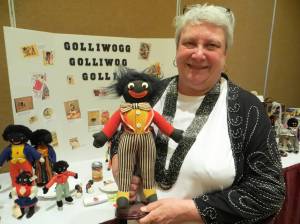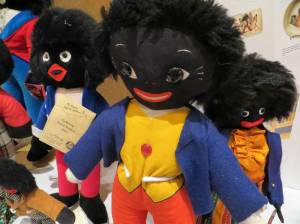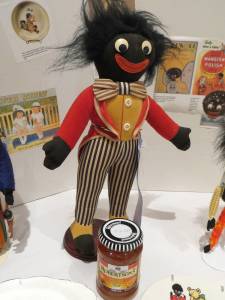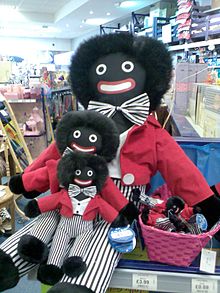Program and display presented by Debra G.
Photos and Summary by Pat D.
Debra shared so many fine examples of the little fellow in varying sizes from tiny to tall, along with books, ads, figures, children’s crock ware, storyboard and Golli friends. Kudos to Debra for a truly interesting and fun program. Plus this was a doll subject of which many were unfamiliar, so it was quite educational as well.
Creator of Golliwogs : Florence Upton ( 1873 – 1922) was the daughter of English parents who had immigrated to the United States. Following the death of her father, she, her mother and siblings moved back to England when she was fourteen. There she spent several years drawing and developing her artistic skills. In order to afford tuition to art school, she illustrated a children’s book entitled The Adventures of Two Dutch Girls and a Golliwogg.
The 1895 book included a character named the Golliwogg, who was first described as “a horrid sight, the blackest gnome”, but who quickly turned out to be a friendly character, and is later attributed with a “kind face.” Stuck for a main character, her aunt, with whom she was staying in Hampstead, North London, found an old battered black-face rag doll in the attic.
As soon as Florence saw him, she knew she had found her protagonist. ‘As the Golliwogg has always seemed to me to be telling me his own biography, so in the same way he must have told me his own name,’ she later said. ‘I picked him up from the table in my studio, and without intention of naming him, without the idea of a name passing through my mind, I called him ‘Golliwogg’.’ It was a completely invented name and one that at the time had no negative connotations.
The Golliwogg had jet black skin; bright, red lips; and wild, woolly hair. He wore red trousers, a shirt with a stiff collar, red bow-tie, and a blue jacket with tails.
Never the most commercially astute of families, Florence and her mother failed to trademark the Golliwogg character, and after the books had proved such a hit in Britain and then Europe, Australia and, to a lesser extent, the United States, toy companies jumped on the bandwagon. Slightly changing the name, they released a flurry of ‘Golliwog’ dolls, toys and badges.
Through the years Florence and her mother Bertha collaborated on a total of thirteen Golliwogg adventures, as the Golliwogg bravely traveled the globe with the Dutch Dolls, Peg and Sarah Jane.
The series ended as gradually a cultural drift caused interest in the series to wane and Florence sought a career as a professional artist. The last of the Golliwogg books was published in 1909.
Florence continued to study and paint, concentrating mainly on portraits. She exhibited at the Royal Academy and other prominent venues and rapidly established a reputation as an accomplished society portraitist. Additionally, she received hundreds of commissions from the families of young soldiers.
For health reasons Florence was found unfit to serve in any physical capacity during the First World War. She instead aided the war effort by donating her original dolls and drawings to a fund-raising auction for the Red Cross, conducted by Christies in 1917. The dolls, sold as a lot for 450 guinneas, funded the purchase of an ambulance, christened ‘Golliwogg’, which went to the front and served in France.
At the age of only 49, Florence Upton died in her studio on 16 October 1922, from complications following surgery.
Commercial History: The earliest Golliwog dolls were rag dolls made by parents for their children and many thousands were made. During the early twentieth century, many prominent doll manufacturers began producing Golliwog dolls. In 1908 Steiff became the first company to mass produce and distribute Golliwog dolls. Today, these early Steiff dolls sell for $10,000 to $15,000 each, making them the most expensive Golliwog collectibles.
The major Golliwog producers were Steiff, Schuco, and Levin, all three German companies, and Merrythought and Deans, both from Great Britain. The Steiff Company is the most notable maker of Golliwog dolls.
During the first half of the twentieth century, the Golliwog doll was a favorite children’s soft toy in Europe. Only the Teddy Bear exceeded the Golliwog in popularity. Small children slept with their black dolls. Many white Europeans still speak with nostalgic sentiment about their childhood gollies. Sir Kenneth Clark, the noted art historian, claimed that the Golliwogs of his childhood were, “examples of chivalry, far more persuasive than the unconvincing Knights of the Arthurian legend”. The French composer Claude Debussy was so enthralled by the Golliwogs in his daughter’s books that one movement of his Children’s Corner Suite is entitled “The Golliwog’s Cakewalk”. The Golliwog was a mixture of bravery, adventurousness, and love for children.
The Controversy: The image of the doll has become the subject of heated debate. While some see the golliwog as a cherished cultural artifact and childhood tradition, others argue that the golliwog is a destructive instance of racism against people of African descent. Manufacturers who have used golliwogs as a motif have either withdrawn them as an icon, or changed the name.
Upton’s book and its many sequels were extremely successful in England, largely because of the popularity of the Golliwogg. The golliwog doll became a popular children’s toy throughout most of the 20th century, and was incorporated into many aspects of British commerce and culture. Upton’s Golliwogg was jovial, friendly and gallant, but some later golliwogs were sinister or menacing characters, such as in the three books by Enid Blyton.
The golliwog contributed enormously to the spread of blackface iconography in Europe. It also made its way back across the Atlantic in the form of children’s literature, dolls, children’s china and other toys, ladies’ perfume, and jewelry.
British jam manufacturer James Robertson & Sons used a golliwog called Golly as its mascot from 1910. Robertson’s started producing promotional Golly badges in the 1920s, which could be obtained in exchange for tokens gained from their products. In 1983, the company’s products were boycotted as offensive, and in 1988 the character ceased to be used in television advertising. The company used to give away Golly badges and small plaster figures playing musical instruments or sports and other such themes. The badge collection scheme was withdrawn in 2001. Today, Robertson’s Golly badges remain highly collectible, with the very rarest sometimes selling for more than £1,000.
In many ways the campaign to ban Golliwogs was similar to the American campaign against Little Black Sambo. In both cases racial minorities and sympathetic whites argued that these images demeaned blacks and hurt the psyches of minority children. However, many collectors, primarily though not exclusively whites, contend that the anti-Golliwog movement represents political correctness at its worst. They argue that the Golliwog is just a doll, and that the original Florence Upton creation was not racist, intentionally or unintentionally.
Current Popularity: The Golliwog celebrated its 100 year anniversary in 1995. In 1995, Steiff produced two anniversary Golliwog dolls, including the company’s first girl Golliwog. In 1996, R. John Wright issued limited editions of Golliwogg, Miss Golly and Gollibabies.
Golliwog collectibles, which always had a loyal following, again boomed on the secondary market. This popularity continues today and is evidenced by numerous eBay and Yahoo internet auctions and the presence of several international Golliwog organizations. Whatever their status, golliwogs are still very popular amassing a whole sub culture of collectors. Ebay sells every kind of golliwog collectable imaginable; dolls, books, cups, key rings, piggy banks and list goes on. Many are in mint condition and a testament to their strong production demand, as of recently collectors is bidding up to £60





You must be logged in to post a comment.